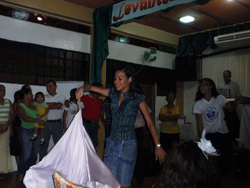It was easy to tell where the meeting was. The teal house was surrounded by people, its patio spilling light out onto the street.
Inside the patio, the scene continued. In one corner, toddlers were clustered around a TV cartoon show. On the other side of the porch, older children were engaged in a lesson about how to show God’s love. And in the midst of it, the host distributed juice and cookies to the newcomers.
Such gatherings are becoming more popular in Venezuela. Encouraged by the Presbyterian Church of Venezuela (Iglesia Presbiteriana de Venezuela, or IPV), these weekly prayer meetings, called “cells,” are often the first step in introducing people to church.
This new evangelism experiment acknowledges that coming to church for the first time can be intimidating. The prayer groups are meant to ease families into a church setting by teaching Bible stories and supporting fellowship in a laidback environment.
The meetings are hosted by church members at their homes. They invite their extended families and neighbors to visit and learn. Over time, a sense of community is established, and some people who have never known church become more familiar with the idea.
The IPV now has eight family cells, with plans to add two more. There are also five cells that focus on children, with the idea that healthy families make for a healthy church.
Close to the prayer meeting in the teal house is the Jacob’s Ladder Presbyterian Church, in the town of Ocumare del Tuy. Here, as in the prayer meeting, the importance of children, youth and family in the church is highly prominent.
The church runs a daily preschool and an after-school tutoring program for children, but it also has educational programs for their parents. Adults can enroll in continuing education programs to learn practical skills like barbering, sewing, jewelry-making or bread-making.
Jacob’s Ladder church also makes sure to include youth at its weekly Tuesday devotional service. At the Jan. 19 service, youth were not simply included or given small roles — they ran the service. Youth led prayers, sang songs, read Bible passages and played instruments.
At the end of the service, the pastor wanted to introduce all members of the church who played a leadership role in some way. He called them up one by one, telling the congregation their contribution to the church. Person after person was called forward. By the end, almost none of the members remained seated — they were standing up front with the rest of the leaders. They were all valued, and they were all essential to the mission of the church.
Looking at them, the meaning of a true church community was clear.

